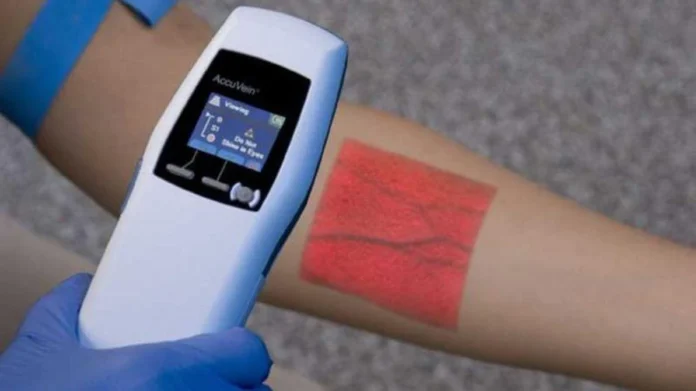Finding a vein can be difficult, especially if you are trying to do it yourself. Luckily, there is a tool that can make the process much easier: the vein finder.
In this guide, we will teach you how to use a vein finder and locate your veins quickly and easily. So, whether you are a nurse or just need to find a vein for IV treatment, read on for all the information you need!
What is a vein finder and what are its uses
Before we start discussing how to use a vein finder, it is important to understand exactly what this tool is and what it is used for. A vein finder is a small, handheld device that uses infrared light to locate veins beneath the skin’s surface.
The device emits a beam of light that is absorbed by the bloodstream and reflects back to the sensor, allowing the user to see the outlines of the veins.
- Vein finders are commonly used by healthcare professionals to insert intravenous catheters, draw blood, or give injections.
- They are also used in cosmetic procedures such as vein therapy, where the device is used to locate and treat spider veins.
- While some vein finders are relatively simple and inexpensive, others are quite sophisticated and can cost several thousand dollars. regardless of price, however, all vein finders serve the same basic purpose: to help healthcare professionals more easily and accurately locate veins.
How does a vein finder work
Here’s the science behind it: Vein finders use a method called transillumination to find veins.
Transillumination is when light passes through tissue to create an image. In the case of vein finders, infrared light is used.
- Infrared light has a longer wavelength than visible light, so it can penetrate the skin more easily.
- When the light hits a vein, it reflects back and creates a shadow on the skin.
- The vein finder then amplifies this shadow so that it’s more visible to the naked eye. And voila! You’ve found a vein.
Of course, finding a vein isn’t always this easy. There are a variety of factors that can make veins more difficult to see, including dark skin, obesity, and dehydration. But for the most part, transillumination is a reliable way to find a hidden vein. I really found the vein locator by AimVien Go 2.0 good and efficient, just made the life easier by saving time and effort as well as reduced needlestick. So, if you want to have one, you can opt for it.
How to use a vein finder
Here’s a complete step-by-step guide on how to use a vein finder:
- Choose the right vein finder for your needs. There are a variety of different vein finders on the market, so it’s important to choose one that is well suited for your particular needs.
- Clean the area where you will be using the device. It’s important to clean both the skin and the device itself before using it.
- Turn on the device and hold it against the skin. The device will emit a beam of infrared light that will help to locate veins beneath the surface of the skin.
- Follow the instructions that come with your particular device. Some devices will require you to move the device around in order to find the best vein, while others may have specific protocols that you need to follow.
- Once you’ve found a suitable vein, use the device to help guide your needle into it. Be sure to sterilize both the needle and the device before use.
By following these simple steps, you can easily use a vein finder to locate veins beneath the surface of your skin.
Tips for finding veins using a vein finder
While a vein finder can be a helpful tool, there are a few things you can do to make the process even easier:
- Drink plenty of fluids. Dehydration can make veins more difficult to see, so it’s important to drink plenty of fluids before using a vein finder.
- Apply pressure. Applying pressure to the area where you will be using the device can help to make veins more visible.
- Use a tourniquet. If you’re having trouble finding a vein, try using a tourniquet. This will help to constrict the blood vessels and make veins more visible.
- Try different positions. Veins can be tricky to find, so it’s important to try different positions. For example, you may find it easier to locate veins in the arms by holding them above the head.
- Be patient. Don’t give up if you don’t find a vein right away. It can take some time and patience to find the perfect vein.
By following these tips, you can make the process of finding veins with a vein finder much easier.
FAQs About Vein Finder
Q: Can you use a vein finder on everyone?
A: Yes, a vein finder can be used on anyone. However, there are a few groups of people who may find it more difficult to use a vein finder. These include people with dark skin, obese people, and dehydrated people.
Q: Is a vein finder painful?
A: No, a vein finder is not painful. The only sensation you may feel is a slight warmth from the infrared light.
Q: How accurate is a vein finder?
A: Vein finders are generally very accurate. However, there are a few factors that can affect their accuracy, including dark skin, obesity, and dehydration.
Q: Do you need a special license to use a vein finder?
A: No, you do not need a special license to use a vein finder. However, it is important to be familiar with the device before using it.
The Bottom Line
So, there you have it! A complete guide on how to find a vein using a vein finder. With this handy tool, you’ll be able to locate veins beneath the surface of your skin with ease. So, what are you waiting for? Give it a try today! We assure you, you won’t be disappointed.


















